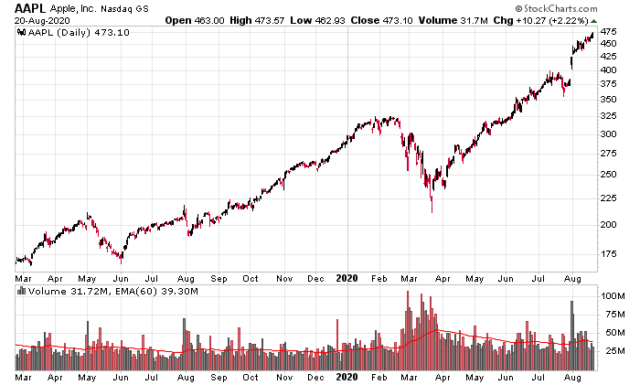Look at this chart since the COVID crisis period (March):
With a market capitalization of $2 trillion, they are now 6.75% of the S&P 500. You buy $100 of S&P 500, $6.75 goes into Apple automatically, without regard to its price.
Along with Microsoft, Google, Facebook and Amazon, that’s 23% of the index in 5 companies.
This is a well known fact. However, portfolio managers that are measured by performance relative to the S&P 500 will find it difficult to keep up if these five companies are the only ones appreciating while the rest are stagnating – so they’ll hedge by putting 23% of their assets in these five while playing the stock market with the other 77%.
Eventually this assimilation of the S&P 500 will get so large that the numbers become truly ridiculous – already rationalizing a $2 trillion market capitalization on an annualized net income of $60 billion – that’s a lot of growth expected from an already large baseline!
Canadian investors shouldn’t find much solace in the TSX either – the Composite’s top component right now is Shopify with 6.16% of the index. However, the rest of the companies aren’t the high-flying technology companies as seen in the S&P.

I am amazed/impressed/horrified by Apple’s rise, and I imagine their stock price can go higher still, but I wonder whether they’ll run short of reinvestment options if they stay the course. The HQ and the entertainment blitz are symptomatic, maybe, of too much money; I understand the strategic rationale for tv+ but it seems like a bit of a stretch and a catchup. Obviously a good problem to have, but I wonder whether we won’t soon see more questionable capital allocation and a slow letting of air out of air out of the bubble. These top 5 cos have faced similar challenges in past, but Apple seems to me to be particularly vulnerable because of its brand identity. Not that such thoughts haven’t, I’m sure, been addressed in greater depth elsewhere!